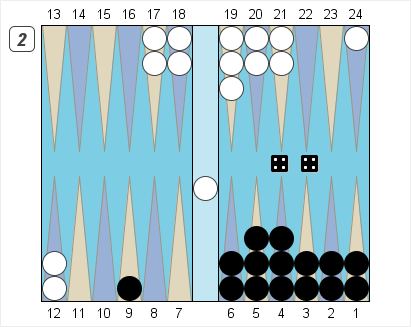Consider the following problem, which arose in a recent chouette:

Black – Pips 60
Black to Play 4-4
As the captain, I had a 4-4 to play. Three plays were possible.
1. 9/5 6/2(2) 4/off. This is clearly the safest play. Black is even with spares on the high point, and White has the opportunity to enter with a 6.
2. 9/1 5/1 4/off. Legal, but this seemed the clearly worst of the three. Black is stripped, and so more likely to leave a shot than with choice (1), while the two extra checkers on the ace-point clearly reduce his gammon chances.
3. 9/5 4/off(3). The gusto play, going full blast for the gammon, at the cost of leaving more potential shots than choice (1) or choice (2).
This is a problem of balancing extra losing chances with extra gammon chances. In backgammon, it’s correct to trade extra losing chances for extra gammon chances if the number of extra gammons is at least twice the number of extra losses. To see why this is so, remember that winning a simple game will net you two points. Winning a gammon increases your net gain to four points, (a gain of two points), but turning a win into a loss takes you from plus-two to minus-two, a net loss of four points. When you turn a win into a loss, you lose twice as much as you gain when you turn a win into a gammon, so you must win at least twice as many gammons before the aggressive play (whatever that may be) becomes correct.
Over the board, my teammates and I could only guess at these numbers. Clearly, our losing chances are small in any case. After play (1), they’re almost non-existent. Even after the risky play, (3), we might easily have six or seven men off when we get hit, so a hit won’t necessarily win for White. On the other hand, White needs 13 crossovers to get off the gammon. [This is computed by seeing that the White checker on the bar needs four crossovers to enter and reach White’s home board, the checkers on the midpoint add another four, and the checkers on White’s 7-point and 8-point require another four, plus a final crossover to actually bear off a checker, a total of 13.] This implies that our gammon chances are fairly good, certainly in the 40%-50% range, so extra checkers off should add to those chances substantially. (We thought.) So we took three men off. We eventually won the game but not the gammon.
Was our play correct? Extreme Gammon’s rollouts actually yield an interesting answer and some intriguing insights.
First, let’s take a look at our losing chances after all three plays. As you might expect, they are low. But let’s see just how low.
Losing Chances after Each Play:
After Play (1) 9/5 6/2(2) 4/off: 1.0%
After Play (2) 9/1 5/1 4/off: 3.0%
After Play (3) 9/5 4/off(3): 5.2%
No real surprises here. The “safe” play of clearing the 6-point and staying even on top is indeed the safest. The unusual play of dumping the spares on the ace-point while keeping a closed board is certainly riskier, raising the losing chances from 1% to 3%. And the bold play of taking off three checkers while leaving a gap is riskiest of all, with losing chances over 5%.
These numbers, however, don’t answer the problem for us. To get an answer, we need to combine these numbers with the gammon chances for each play. And here some real surprises await.
Gammon Chances after Each Play:
After Play (1) 9/5 6/2(2) 4/off: 45.3%
After Play (2) 9/1 5/1 4/off: 54.4%
After Play (3) 9/5 4/off(3): 48.7%
As you can see, Black is winning a gammon roughly half the time in this position. The safe play (1) wins the fewest gammons, which is not unexpected. But the “aggressive” play (3) isn’t really so aggressive after all. It wins only slightly more gammons than play (1). The real surprise is the awkward-looking play of putting both spares on the ace-point (2), which wins far more gammons than either of the other two plays!
It’s not hard, given these figures, to see what the right play is. Compared to the safe play (1), the aggressive play (3) wins 3.4% more gammons at a cost of 4.2% more losses. Since we need to see twice as many extra gammons as extra losses to make an aggressive play superior, play (3) is clearly inferior to play (1). The two checkers that Black bears off are more than offset by the awkwardness of the open 4-point, which requires Black to waste full rolls and half rolls later on to avoid leaving a shot.
However, the awkward-looking play (2) is somehow the real deal. It wins 9.1% more gammons than (1), at a cost of just 2% more losses. The 2-to-1 ratio of extra gammons to extra losses is easily satisfied, so (2) is better than (1), and (1), as we saw, was better than (3).
Now we know the proper ranking of our three plays, but how can we explain it succinctly? The lesson of this problem (and it’s a very counter-intuitive lesson) is this: the real strength of play (2) is that it keeps a 6-point board, even if only for one turn. When White can enter on the first turn in plays (1) and (3), he eliminates much of the gammon danger. Keeping White on the bar, even at the cost of an awkward position with both spares on the ace-point, is worth it. But this is a very hard play to find, and few players would find the right play in this sort of position.





